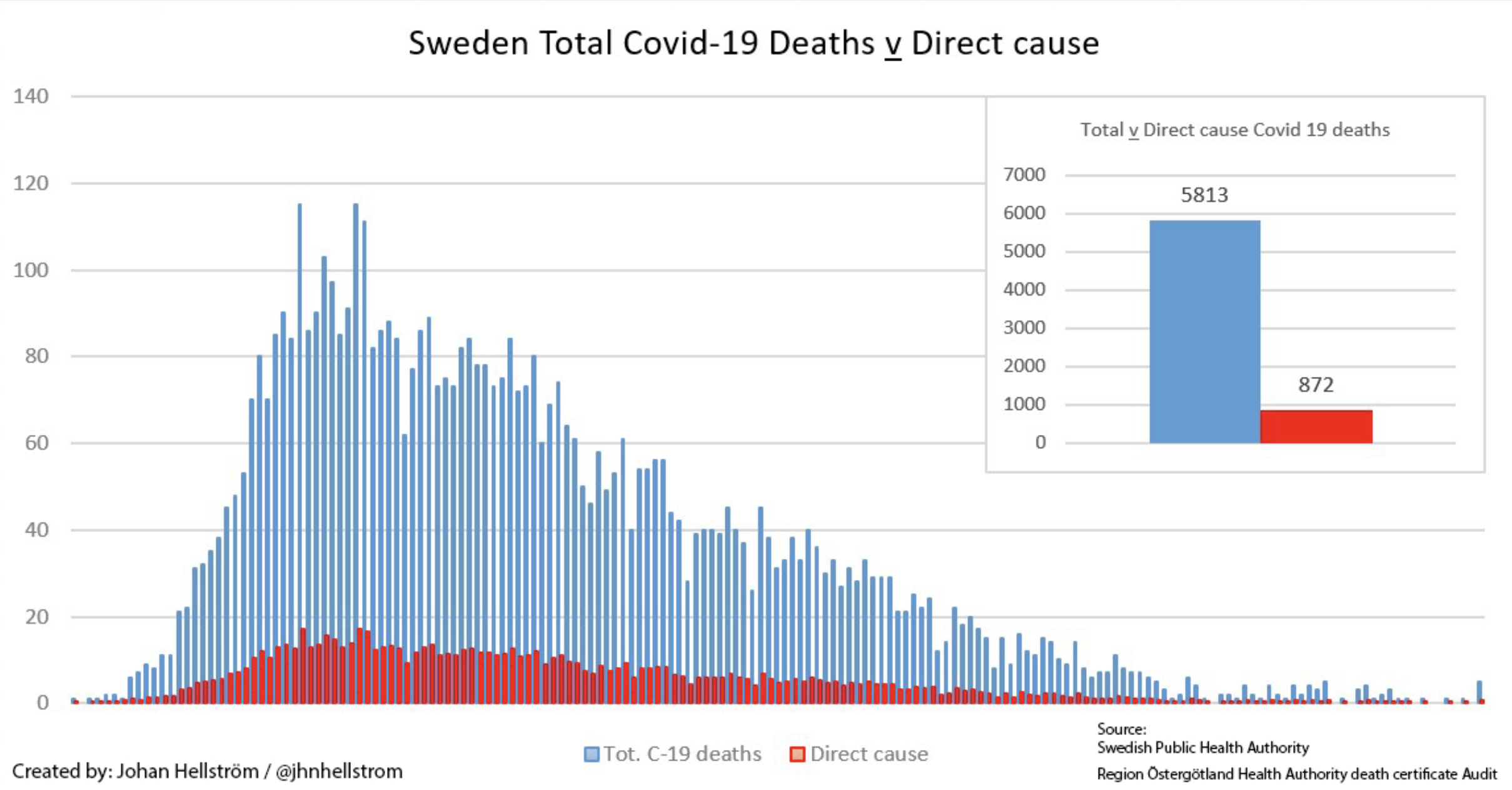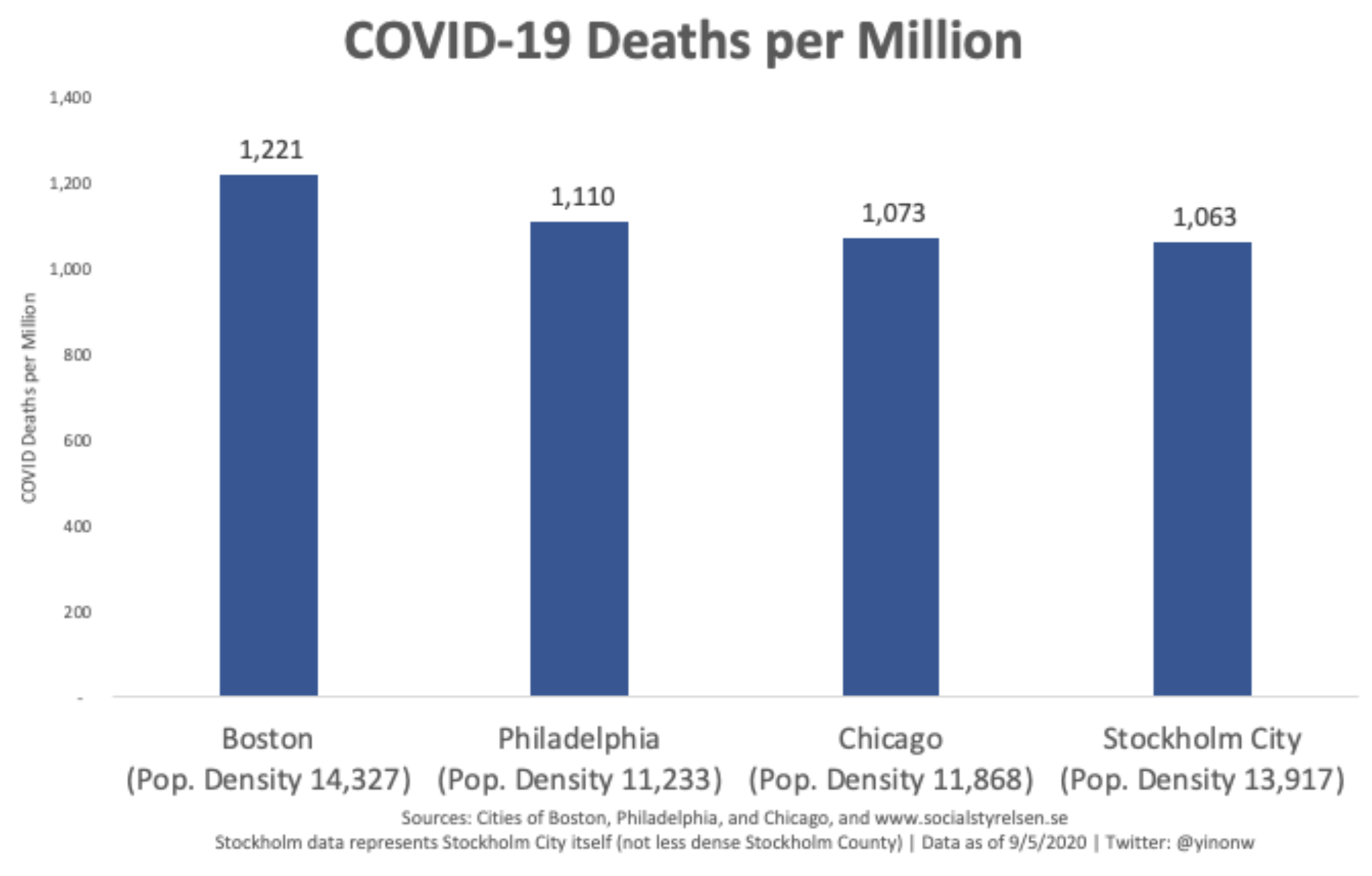Sweden, as usual, leads the way on transparency. This chart courtesy of Twitter, shows the results of a Swedish evaluation of death certificates to determine in how many deaths “with” coronavirus, it was the actual underlying cause of death. You can see that it is a low percentage.

And this second graph demonstrates that population density doesn’t account for the differential Swedish outcomes. Despite using much less harsh lockdown measures, it had the same mortality outcomes as US cities with similar population densities.

One final thing about Sweden. A serious question: If masks are so damn important, how does Sweden, in which no one wears masks, basically have no cases now.


Good ones! Thanks.
Thank goodness we have Sweden. Otherwise Team Hysteria would be able say that lockdowns were the cure worldwide from the really bad pandemic Imperial College predicted.
Aren’t hearing much about Sweden now, are we? No NYTimes front page stories about a disaster it is.
Are you able to deep dive into the hospitalization data?
When MDH reports hospitalizations, it is difficult to tell if CV was the reason for hospitalization.
Do the hospitalizations also include people who went into hospital for something completely unrelated to CV, then got tested for CV at some point, and end up being counted as a CV hospitalization?
The state provides very little detail on hospitalizations. We don’t get actual day of hospitalization, we don’t get day of discharge, we don’t get average length of stay. I am hoping the new CDC data will help with some of that. Some of the hospitalizations are definitely due to other causes and the person just happens to test positive. The state does not break those out. There are definitely patients who get CV in the hospital. The state doesn’t break those out. Very frustrating.
@Kevin Roche – THANK YOU very much for troubling yourself to look into it, though. It is both sad and maddening that local media outlets don’t seem to care about interpreting data in its entirety. When you add in the unreliable nature of the tests, and then they throw these numbers at you as if you are supposed to take them at face value, it is even more maddening.
Maybe there is another angle you have already tried to look into with respect to Minnesota that I suspect is extremely relevant to hospitalizations and fatalities, and that is obesity level (Body Mass Index).
MDH website on obesity says, “The state’s adult obesity rate in 2018 was 30.1%, up from 28.4% in 2017.”
There is a recent Science Magazine highlighting the issue:
“Why COVID-19 is more deadly in people with obesity—even if they’re young”.
sciencemag.org/news/2020/09/why-covid-19-more-deadly-people-obesity-even-if-theyre-young
“…Since the pandemic began, dozens of studies have reported that many of the sickest COVID-19 patients have been people with obesity. In recent weeks, that link has come into sharper focus as large new population studies have cemented the association and demonstrated that even people who are merely overweight are at higher risk. For example, in the first metaanalysis of its kind, published on 26 August in Obesity Reviews, an international team of researchers pooled data from scores of peer-reviewed papers capturing 399,000 patients. They found that people with obesity who contracted SARS-CoV-2 were 113% more likely than people of healthy weight to land in the hospital, 74% more likely to be admitted to an ICU, and 48% more likely to die.”
IIRC, the MDH and/or the CDC may have said “severe obesity” (according to CDC classifications based on BMI, Class 3) was a risk factor.
Come on now…and the CDC classification of “obese” (Class 1 or 2) is NOT a risk factor?
Getting the data on BMI of patients and fatalities could be potentially illuminating, especially for those in younger age brackets.
The cynical side of me says MDH/CDC avoids the subject because they are terrified of accusations of “fat shaming”.
Reality might be they are not bothering to emphasize this aspect for any number of less cynical reasons.
Interestingly, a quick google search also indicates medical articles discussing the link between obesity and vitamin d deficiency, with various medical articles on the topic. And there are plenty of articles pre-CV in regards to vitamin d levels and respiratory illness.